![]() MARK GARDINER (with help
from Neil Mackenzie)
MARK GARDINER (with help
from Neil Mackenzie)
![]()
Day Three - Monday 21 May
This was going to be one of our longest days. The territory covered was a large swathe to the south of Ypres, covering all the cemeteries south of Wijtschate to Mesen (Messines), running west to Loker and Dranouter, with a late dash to the east to take in Zandvoorde as the two burial places in the latter village didn't fit easily into any other route. It was misty, threatening to rain but never quite managing more than a little drizzle at times, until the sun finally broke through in mid-afternoon.
Our first stop was at Torreken Farm Cemetery No.1 just south of Wijtschate, which is a small isolated front-line cemetery reached via a fenced path through farmland; despite the "Beware of the Bull" sign the only threat seemed to come from a dog who sounded tough but turned out to be cowardly as we approached! As we often found with these smaller cemeteries (91 burials) there was no registry box. We were visiting: -
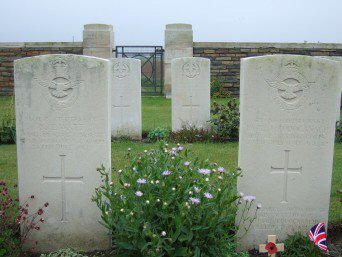
Second Lieutenant Paul John Rodocanachi of 53rd Squadron, Royal Flying Corps (the same unit as Second Lieutenant Middleton who was buried in the last cemetery we had visited the previous evening). Born in Calcutta he was educated at Repton and gave his age as 18 when he enlisted (although CWGC records indicate he was 17 when he died). On 29 July 1917 his aircraft was shot down by Lt Ernst Hess of Jasta 28 at 3pm in the Messines-Wytschaete area; 2/Lt Rodocanachi was flying an RE8 with 2/Lt Norman Watt as his observer. Rodocanachi was killed outright, Watt was mortally wounded but managed to land the plane before dying and is buried next to Paul. The Rodocanachi family helped British personnel on the run in France between 1940 and 1943 during World War two. The Gestapo broke the escape line and Dr. Georges Rodocanachi was deported to Buchenwald concentration camp where he died.
Private Joe Williamson of 8th Bn. East Lancashire Regiment who was killed on the first day of Third Pyres (31 July 1917), who is commemorated on the Accrington War Memorial. Neil noted that although CWGC records state Pte. Williamson is buried in grave C7 he is actually in C8; Pte. Joseph Walsh of the same battalion who died on the same day is actually buried in C7 (and this is correctly recorded).
Nor far down the country roads is Cabin Hill Cemetery, another small front-line burial ground started in 1917 lacking a registry box. We found the best place to park is outside the adjoining farm complex and walking down past the well-populated duck pond. Second Lieutenant Frank Mewburn Dunn of 10th Bn. Durham Light Infantry, who fell on 23 September 1917, is buried here. He was born in Toronto and had enlisted in the Canadian Army Medical Corps, before being commissioned into the Durham Light Infantry on 27 June 1917. Although the battalion war diary does not record the circumstances of his death, they suffered enemy shelling all day as well as machine-gun and rifle grenade / mortar fire and an attack by a lone German aircraft.
Derry House Cemetery No.2 is unusually laid out, comprising two distinct parts, probably a legacy of its status as a front-line burial plot. Corporal William Turvey of 12th Australian Light Trench Mortar Battery hailed from Western Australia and had enlisted in May 1915 before being sent to the Dardanelles in a reinforcement draft for the 11th Bn. Australian Infantry, where he almost immediately contracted dysentery and was first evacuated to Mudros, then Malta; he ended up in England. In April he joined the 48th Bn. at Tel-el-Kebir and landed at Marseilles in June 1916 before joining the Trench Mortar Battery. He was killed during enemy shelling of Hill 63 (Fort Garry) with high explosive, shrapnel and gas, although there are conflicting reports of how he died, and also his date of death (CWGC records state 16 August 1917 although other records indicate 15, 17 or 18 August).
Onwards to the east of Messines to Bethleem Farm West Cemetery which lies at the bottom of a slope leading up to the village. The cemetery contains many Australian casualties, mostly from the 33rd & 35th battalions. We were visiting: -
Company Serjeant Major Walter Stacker of 35th Bn. Australian Infantry was a British-born labourer from New South Wales who enlisted in November 1915 and was promoted to CSM in June 1917, before being killed on 21 July 1917.
Private Arthur Boyes of 100th Coy. Machine Gun Corps (Infantry) died on 9 November 1917; his family lived in Great Harwood and he is commemorated on the local war memorial.
On the other side of the shallow valley is Bethleem Farm East Cemetery in which again Australians proliferate amongst the casualties. There was no registry box but plenty of hares. We were visiting Lieutenant Richard Walsh of 44th Bn. Australian Infanty who died on 8 June 1917. Lt. Walsh came from Tasmania, and had previously been a drill instructor having served 7 years in the Australian reserves, and also spent 5 years on the instructional staff. He enlisted in February 1916 and was almost immediately commissioned as a Second Lieutenant, arriving at Plymouth in July 1916. He was killed during a successful attack on the Green Line during the Battle of Messines, during which Allied artillery shells fell short; the Official History records him as being hit by a sniper. The original inscription chosen for his headstone exceeded the 66 character (including spaces) limit and had to be abbreviated by his mother.
Into Mesen to visit Messines Ridge British Cemetery and Messines Ridge (New Zealand) Memorial. The latter is at the entrance to the former and amongst those commemorated is Private Robert Leaf of 2nd Bn. Auckland Regiment, who had enlisted in October 1916, and was killed in action aged 30 on 1 August 1917. Three brothers also served overseas, and two were invalided home.
The cemetery is a large concentration burial ground with many unidentified burials. We were visiting Lieutenant Jonathan Becker of 2nd Bn. East Surrey Regiment, who was killed on 12 March 1915 during an unsuccessful postponed attack on Spanbroekmolen, possibly when British artillery shells fell short on the battalion's position near Lindenhoek. His body is believed to lie in the cemetery along with two other officers of the same battalion killed on the same day whose special memorials flank his: 2/Lt. Crabb & 2/Lt. Kirtland. Another officer lies in an identified grave: 2/Lt. de Buriatte in II.B.3, who is surrounded by unknown burials. Is it possible that amongst these could be found his fellow officers?
On the road from Mesen to Wulvergem is the Farm de la Plus Douve, a large working farm complex, which contains two cemeteries. The first we visited was La Plus Douve Farm Cemetery, which is a spacious and well-designed cemetery, containing many Australian, New Zealand and Canadian casualties. We were visting: -
Second Lieutenant B J McCann of 18th Bn. Royal Irish Rifles, who had enlisted in Belfast aged 21 in November 1914 and since then had served with the Leinsters, the Inniskillings and the Royal Munster Fusiliers, being wounded whilst with the latter at Suvla Bay, Gallipoli. He was commissioned into the Royal Irish Rifles on 6 July 1916, and was killed in action on 14 November 1916.
Private T J Dugmore of 1st/8th Bn. Royal Warwickshire Regiment who lived in Birmingham and died on 23 May 1915; we paid our respects two days before the 92nd anniversary of his death.
A very short walk away is Ration Farm (La Plus Douve) Annexe which is a very long and narrow cemetery. We were visiting Private George Kerruish of 13th Bn. Middlesex Regiment on the anniversary of his death on 21 May 1916. He was a motor driver from Ramsey on the Isle of Man, who only arrived in France on 19 April 1916 and died within a week of joining his battalion, whose war diary indicates this was a quiet period in the trenches with "nothing of importance" occurring; there was one killed in action and one casualty who died of wounds - the other man almost certainly being Lance Corporal Hooper of 13th Bn. who is buried nearby and died on 23 May 1916.
Both of the last two cemeteries are visible from nearby St. Quentin Cabaret Military Cemetery which is another well-designed burial ground, beautifully laid out in a fan shape on slightly rolling ground. We were visiting: -
Captain William Graham of 5th Bn. Northumberland Fusiliers who was a schoolteacher in the Territorial Force and a Serjeant in the 5th battalion pre-war, who had been commissioned in 1913. He married Annie Evelyn Graham on 14 October 1914. He was killed outright aged 25 when shot by a sniper whilst looking over the parapet on 24 June 1915, and was buried by the Brigade Chaplain outside battalion headquarters. His daughter, Flora Elizabeth, was born on 10 November 1915, so he never saw her.
Private A Plant of 1st/5th Bn. South Staffordshire Regiment, who died on 21 May 1915 - we paid our respects on the 92nd anniversary of his death.
Rifleman John Westbrook of 12th Bn. Royal Irish Rifles, formerly of 1st/5th Bn. London Regiment (London Rifle Brigade), who died on 10 March 1917. He was a Croydon lad who had attended Whitgift Middle School.
Getting to our next stop, Kandahar Farm Cemetery was a problem as it was difficult to get onto the N314 as the road between Wulvergem and Nieuwkerke was under renovation - in Britain it would have been closed, but we followed some local drivers (on both sides of the road)! The cemetery itself seems little visited, as we were only the 5th party to sign the visitors' book in 2007.
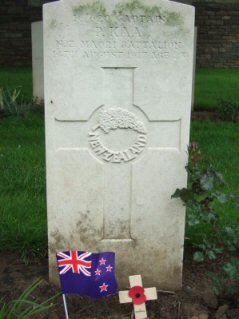
We were visiting Captain Pekama Rongoaia Kaa of the New Zealand Maori (Pioneer) Bn. who had enlisted in the 1st Maori Contingent in June 1915, and had been commissioned in September 1915 just before leaving New Zealand. Capt. Kaa came from a notable line of Maori warriors of the Ngatiporou tribe; he won the Makanui scholarship at the Rangitukia Native school, then studied at Te Ante College, leaving there to enter the Dept. of Agriculture after passing the Junior Civil Service exam. He and several of his men were caught by shellfire while in a very awkward sector of trench on 14 August 1917. Several were killed outright whilst others, including Pekama, were wounded. He refused to be evacuated until all his men had been moved and while he was waiting another shell burst killed him on the spot aged 23.
A longish drive to Dranouter Churchyard where the CWGC graves are in two well-maintained grassed plots, a contrast to the red shale of the civil churchyard; although there are 79 burials there is, as is usual with churchyard burial sites, no registry box. We were visiting Lieutenant Robert Bradford Flint of 59th Field Coy. Royal Engineers, from Bromley in Kent, who had applied to the Royal Military Academy in 1909. His unit were working in the Wulvergem-Dranouter sector on 22 January 1915 on various tasks when he was wounded, and he died on the following day aged 23. He had been awarded the DSO.
Nearby Dranoutre Military Cemetery has its gates missing, but good views across the valley. The headstones are in orderly rows but the flowering shrubs and lack of a drystone retaining wall make this cemetery appear less regular than some. We were visiting: -
Rifleman William Baird of 14th Bn. Royal Irish Rifles on the anniversary of his death (21 May 1917).
Second Lieutenant Thomas Hanson Averill of 17th Bn. The King's (Liverpool Regiment), a clerk of works from Great Witley near Worcester. He had attested to the Army Veterinary Corps in January 1915 and worked his way up to Acting Serjeant before being commissioned in April 1917. He was killed on 30 August 1917 whilst his company was engaged on working parties in the front line along with Serjeant Johnson, who is in the next grave.
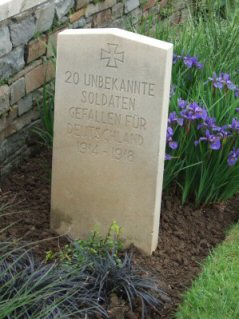 |
Locre No.10 Cemetery is a narrow cemetery on the road between Dranouter and Loker with a gap at the front where French graves used to be, and Germans buried in mostly mass graves; there is no registry box. There are many London Scottish casualties from 21 August 1918. We were visiting one of these, Private Jack Johns of 14th Bn. London Regiment (London Scottish), who was a professional golfer from Ashford in Middlesex, who attested in January 1916 and served with 2/14th battalion at Salonika and in Egypt, where he had served 10 days close confinement for ignoring a battalion march order when he bought oranges from a hawker en route. |
Attempts to find somewhere for lunch in Loker foundered. There are two fair-sized CWGC burial plots in Loker Churchyard where Lieutenant William Meredith of 3rd Bn. Royal Munster Fusiliers was laid to rest. He was attached to 2nd Bn. South Lancashire Regiment who were serving in the trenches at Locre on 20 February 1915 when he was severely wounded, later dieing of his wounds at No.7 Field Ambulance aged 38.
Locre Hospice Cemetery is an isolated burial ground most famous for the grave of Major William Redmond which lays a few yards in the corn field beyond the cemetery boundary wall. We were visiting Brigadier General Ronald Campbell Maclachlan DSO of the Rifle Brigade, Officer Commanding 112th Infantry Brigade. He was educated at Eton and Sandhurst, and had joined the Rifle Brigade in 1895, seeing active service in South Africa (the siege of Ladysmith) and Tibet, before becoming adjutant of Oxford University OTC in 1908, being appointed to command it as a (temporary / acting?) Lieutenant Colonel in June 1914. At the outbreak of war he helped raise the 8th (Service) battalion, taking it to France in May 1915, being promoted to Lieutenant Colonel in June 1915. He was severely wounded at Ypres in December 1915 according to one source, and at Hooge in July 1916 according to another, and was awarded the DSO in May 1916. Promoted to Brigadier General on 7 January 1917, he was killed by a sniper on 11 August 1917 whilst touring the trenches in the Oosttaverne sector. He had two brothers: Major Neil Campbell Maclachlan, accidentally killed on the Mohaman Expedition on the North West Frontier 24 May1908; and Lt-Col. Alexander Fraser Campbell Maclachlan (CMG, DSO and Bar) of King's Royal Rifle Corps but commanding 12th Bn. Rifle Brigade who died on 22 March 918 and is buried at Savy British Cemetery near St Quentin.
After a solid pasta lunch at a roadside restaurant on the southern slopes of Mount Kemmel, with commanding views across the countryside, we arrived at the small roadside Lindenhoek Chalet Military Cemetery, which is quiet but not often visited. We were visiting Private Cecil Beadman of 1st/5th Bn. Leicestershire Regiment just after the anniversary of his death on 19 May 1915, who hailed from East Grinstead.
Packhorse Farm Shrine Cemetery is another small, isolated site, just off the road back to Wulvergem, lacking a registry box. Most burials are from the Leicestershire and Lincolnshire Regiments, and includes the brothers Private Ernest Arthur Proctor and Private James Emerson Proctor of 1st/5th Bn. Lincolnshire Regiment, from Scunthorpe aged 22 & 21 respectively. The were killed on the same day, 20 May 1915, either in the explosion of an enemy mine under their trench in the Dranoutre sector, or in the subsequent rescue attempt.
Originally sited at a dressing station, Wulverghem-Lindenhoek Road Military Cemetery now contains over 1,000 burials with the addition of various graves from the surrounding battlefields, but is surprisingly lightly visited. We were visiting Second Lieutenant Arthur Pickworth of 2nd/16th Bn. London Regiment (Queen's Westminster Rifles) from Tooting, who attested in February 1917; he was seen as "unimpressive at first but a very sound and very intelligent man. He possesses very much more vigour than appears at first sight, is an athlete" and was commissioned on 25 March 1918. Based at Wulvergem, he was killed in a successful attack on the German lines 1,500 yards east of Messines on 28 September 1918 aged 19.
| The CWGC burial plot in Wulvergem Churchyard is small with a grass surround, but bare earth over the graves. We were visiting Lieutenant Thomas Ditmas of 1st Bn. Devonshire Regiment who was born in Plymouth on New Years Eve 1887, the son of a Lieutenant Colonel. He was killed by enemy shelling on 14 January 1915 according to the battalion war diary; CWGC records initially gave his date of death as 11 January but have updated their database following Neil's representations. | 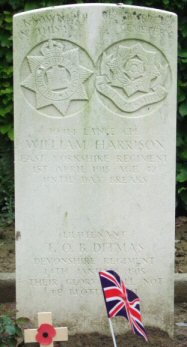 |
Pond Farm Cemetery is a well-maintained site seemingly in the middle of nowhere, accessed via long pathways that go through a farmyard. We were visiting Second Lieutenant Robert Gurnell on the anniversary of his death (21 May 1917). He enlisted in 18th Bn. Royal Irish Rifles in Belfast in November 1915 and made Lance Corporal before leaving to join an officer cadet battalion on 28 February 1917. As the 18th battalion never left Ireland, it is difficult to determine with which unit he was on active service when he was killed aged 20.
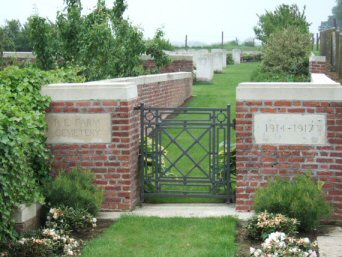 |
Another out-of-the-way cemetery is R.E. Farm Cemetery which is again seldom visited, and is like a walled garden. We were visiting Private Henry Sorette of 2nd Bn. Canadian Infantry (Eastern Ontario Regiment) who was born in St. Malo, Brittany, France in 1874. He was one of two men killed on 12 October 1915 when the enemy bombarded the trenches with rifle grenades during the night & early morning; the other, Pte. E Ward, is buried in an adjoining grave. |
Lone Tree Cemetery may appear to be small (no registry box) and in a lonely location, but is better known as the final resting place of men of the Royal Irish Rifles who were caught by the falling debris from a late exploding mine on 7 June 1917, the opening day of the Battle of Messines. The nearby crater is now known as The Pool of Peace. We were visiting Second Lieutenant William Small Ferris of 12th Bn. Royal Irish Rifles who also fell on that day, but not in the blast. He attended Sherry's Civil Service College and was a sampler for Brakpan Mines Ltd in Transvaal from June 1912 to May 1913 and then employed as shift boss until December 1915. In Union of South African Army (2nd Transvaal Scottish) for 10 months (September 1914 to August 1915) as Private and served during German South West African campaign. When he reached England travelling privately it was recommended that he be attached to the Royal Engineers' tunnelling companies given his past experience, but this does not appear to have occurred. He was commissioned on 4 August 1916.
Across the fields is Spanbroekmolen British Cemetery; another lonely cemetery in the middle of agricultural land, with no registry box, and mostly comprising Irish casualties from 7 June 1917. One of these was Second Lieutenant Sydney Downey of 14th Bn. Royal Irish Rifles, who was killed during the attack on Scott Farm and Jump Point whilst commanding a mopping-up platoon.
After this there was a lengthy drive (comparatively) towards Zandvoorde across the territory captured by the British Army in both 1917 and 1918.The CWGC plot in Zandvoorde Churchyard is a small shale area containing the graves of 4 officer & men of the 10th (Prince of Wales's Own Royal) Hussars who all died on 26 October 1914.One of these is Captain Sir Frank Stanley Day Rose, who had seen action in the Boer War, and was killed aged 37 during heavy shelling. His father, Sir Charles Day Rose, was: Liberal & Free Trade MP for Newmarket 1903-1910 & 1911-1913; Chairman of The Royal Automobile Club in 1907 & 1908 who obtained site of the old War Office in Pall Mall for a new headquarters; member of The Jockey Club and the National Hunt Committee who donated £3000 in 1890 for the encouragement of long distance races, owned Bona Vista which won 2000 Guineas in 1892, and sired Cyllene which won both the Jockey Club Stakes and the Ascot Gold Cup in 1898 & 1899. He died in 1913 after taking his first flight in an aeroplane and passed on the Baronetcy to his son.
Our final stop of the day was at Zantvoorde British Cemetery, an immaculately maintained post-war concentration cemetery. The local municipal authority has erected an excellent information panel outside with pictures of a handful of those buried within. We were visiting: -
Serjeant Louis McGuffie VC of 1st/5th Bn. King's Own Scottish Borderers. He was awarded his VC for an action on 28 September 1918 near Wytschaete, during an advance on Piccadilly Farm when he entered several enemy dug-outs and, single-handed, took many prisoners. During subsequent operations he dealt similarly with dug-out after dug-out, forcing one officer and 25 other ranks to surrender. During the consolidation of the first objective, he pursued and brought back several of the enemy who were slipping away and was also instrumental in rescuing some British soldiers who were being led off as prisoners. Later in the day, while commanding a platoon, he took many more prisoners, but was killed a few days later on 4 October 1918 aged 25 by a shell whilst his unit was in reserve.
Second Lieutenant Henry Marvin of 6th Squadron, Royal Flying Corps, based at Abeele Aerodrome. A resident of Coulsdon, he is commemorated on both the Coulsdon and Purley & Coulsdon war memorials. He enlisted in 28th Bn. London Regiment (Artists' Rifles) on 5 September 1914, and joined the R.F.C. in February 1916. He was killed in action on 26 October 1917 aged 22. On 16 November 1917 21st Divisional Artillery learned that 2 charred & unidentifiable bodies have been found in an aeroplane at 28.J.1J.d.70.05. From number on the Vickers machine gun (A4587) the craft was identified as RE8 (A3850) used by Lieutenants Marvin (pilot) & Barton (observer) - 2nd Lt. Clarence Henry Barton is buried in the next grave.
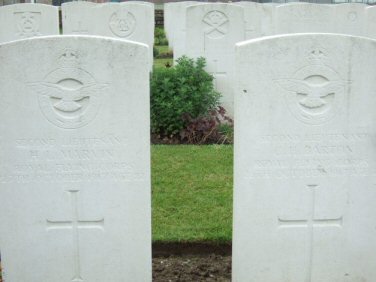
A letter from his father dated 9 February 1918 quotes a Major Ryan: -"At 11:35 a.m. on 26 October 1917 I suddenly saw the machine in a shell burst and it went to pieces, and the remnants crashed in the Salient. There were no other machines or shell bursts in the vicinity." It was noted that deaths were instantaneous. Also stated that Major C.A. Allen (11th Bn. Royal Sussex Regt.) & Capt. G.E.F. Hunt (12th Bn.) of 116 Brigade 39th Division had found & buried the bodies. They had been able to identify Barton by his identity disk & watch. A letter from Capt. Hunt dated 28 November 1917 detailed he was with Capt. Allen just beyond Dumbarton Lakes north of the Menin Road at noon on 30 October 1917. His brother Donald (2/Lt., 1st Bn. Seaforth Highlanders) was killed in action on 9 May 1915 & is buried in Woburn Abbey Cemetery, Cuinchy.
We had covered 44/43 miles in 9¼ hours.
Neither of us can remember where we ate and drank that evening (possibly the Sultan) so the beer at least must have been good!
| Continue reading the Salient Tour Account - DAY 4 |
![]()
 Copyright © Mark Gardiner,
March, 2008
Copyright © Mark Gardiner,
March, 2008
Return to the Contents Section